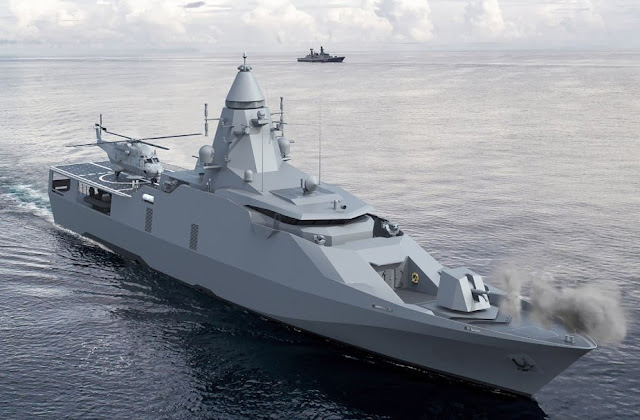By Stijn Mitzer and Joost Oliemans
It's not only Turkish drones that have found export success on the international market. Other segments of Turkey's arms industry are also subject to critical acclaim on the world stage. Sometimes this includes systems that for their less glamorous (but nonetheless highly important) roles receive little attention by international analysts, as is the case with the recent purchase of MEMATT mine-clearance vehicles by Burkina Faso and Togo. [1] [2] Other platforms receive more attention, as was recently the case with Nigeria's acquisition of two 76m offshore patrol vessels (OPVs) from Turkey's Dearsan Shipyard.
The purchase of the two OPVs is a notable success for Dearsan Shipyard considering the stiff competition in today's wide market. The Nigerian Navy currently operates a sizeable fleet of OPVs acquired from countries like China, the United States, Israel and Singapore. For its most recent OPV requirement Nigeria is believed to looked at designs from shipyards in China, the Netherlands and Israel before ultimately settling on the OPV 76 design by Dearsan Shipyard as part of its 2021-2030 fleet-renewal plan.
Both ships are to be constructed by Dearsan
Shipyard (in a joint venture with Gülhan Shipyard) in Istanbul and are scheduled for delivery to the Nigerian Navy within 37 months. [3] The ships will be outfitted with mostly Turkish-designed and produced sensors and weapon systems. The CEO of Dearsan further revealed that the deal also includes the transfer of technology and expertise to Nigeria. [3] The Nigerian Navy is already proficient in the design and construction of small patrol boats, and a technology transfer from Dearsan could see it undertake larger naval construction projects in the future. [4]
Dearsan
Shipyard itself has over time become the
main
supplier of
the Turkmenistan Navy and State Border Service. To date, Dearsan
Shipyard has delivered one Deniz Han corvette, ten NTPB patrol boats,
six FAC 33s, ten FIB 15 fast
intervention boats, a 27-meter landing craft, one HSV 41 hydrographic
survey ship, a catamaran for personnel transport and two tugs
to Turkmenistan. [5] The country's naval build-up has meanwhile transformed Turkmenistan into the
strongest naval power in the Caspian Sea, not in the least through the efforts of Dearsan Shipyard. [5]
The original design layout marketed by Dearsan features a 76mm Leonardo Super Rapid Gun on the bow, a 40mm OTO Marlin 40 on the rear superstructure, two 12.7 mm remote weapon stations (RWS), two manned 12.7 mm HMGs and 2x2 MANPADS stations along with the required radar and sensors, yet Nigeria has opted for a different armament suite for its two ships. As Turkey is increasingly localising its own defence needs, soon also manufacturing a domestic copy of the Italian 76mm gun, Turkish shipyards no longer have to rely on foreign-made weaponry when offering their ships for export. [7]
In fact, the only weapons system on Nigeria's OPV 76s not sourced from Turkey is the 40mm OTO Marlin 40, which replaces the 76mm gun otherwise found on the bow. The Marlin 40 position on the rear superstructure is replaced by a 25mm Aselsan STOP RWS while three 12.7mm Aselsan STAMP RWS replace the MANPADS stations. Several manned machine guns complete the armament suite. Other Aselsan products on the ship include a MAR-D 3D search radar, an Alper LPI navigation radar and a DenizGözü-AHTAPOT (Sea Eye-Octopus) EO/IR sensor system. [8]
 |
An image of the OPV 76 depicting the original armament suite on offer. |
 |
The NMS Unity (F92), one of Nigeria's two Chinese-made P18N class OPVs. Note the A109 coming into land on the helicopter deck. |
More than just arranging for the sale of OPV 76s to Nigeria, the deal also proves that Turkish shipyards no longer have to rely on foreign-made weaponry when offering their ships for export. It won't be long before the Turkish defence industry will be capable of producing every type of associated armament, including cannons, anti-ship missiles, air-defence missiles and equipment such as radars and vertical launching systems (VLS). At this pace, Turkey will likely be self-sufficient in nearly every requirement for its defence sector in ten to fifteen years. Its journey to this self-sufficiency is arguably the fastest of its kind occurring today, surpassing even that of South Korea. Countries currently supplying weaponry to Turkey might in ten years instead be acquiring it from Turkey, showing the fruits of decades of investment in its defence industry.
[1] Turkey to Export Unmanned Mine Clearing Equipment to Burkina Faso https://www.thedefensepost.com/2021/07/30/turkey-minesweepers-burkina-faso/
[2] Togo gets Turkish remote-controlled mine clearance vehicles https://defensehere.com/en/HaberDetay/togo-gets-turkish-remote-controlled-mine-clearance-vehicles/1
[3] Turkey’s Dearsan Shipyard to Build 2 OPVs for the Nigerian Navy https://www.navalnews.com/naval-news/2021/11/turkeys-dearsan-shipyard-to-build-2-opvs-for-the-nigerian-navy/
[4] Hull of Nigeria’s Seaward Defence Boat 3 (SDB III) comes together https://www.africanmilitaryblog.com/2020/05/hull-of-nigerias-seaward-defence-boat-3-sdb-iii-comes-together
[5] Small But Deadly - Turkish Fast Attack Craft In Service With Turkmenistan https://www.oryxspioenkop.com/2021/03/small-but-deadly-turkish-fast-attack.html
[6] Offshore Patrol Vessel OPV 76 http://www.dearsan.com/en/products/naval-vessels/offshore-patrol-vessel-opv76
[7] MKEK’nin 2023 Vizyonunda Hedef 76mm’den Sonra 127mm Deniz Topu’nu da Millileştirmek! https://www.defenceturkey.com/tr/icerik/mkek-nin-2023-vizyonunda-hedef-76mm-den-sonra-127mm-deniz-topu-nu-da-millilestirmek-4845
[9] 'Turkey aims to boost cooperation in defense industry with Nigeria' https://www.aa.com.tr/en/africa/turkey-aims-to-boost-cooperation-in-defense-industry-with-nigeria/2396812
[10] Turkey, Nigeria determined to deepen cooperation: Erdoğan https://www.dailysabah.com/politics/diplomacy/turkey-nigeria-determined-to-deepen-cooperation-erdogan
[11] French media eyes Turkish drones during Erdoğan’s Africa trip https://www.dailysabah.com/business/defense/french-media-eyes-turkish-drones-during-erdogans-africa-trip
Recommended Articles:

.png)







